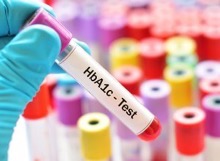 The haemoglobin A1c blood test is 'highly unreliable' at diagnosing diabetes and tends to underestimate the prevalence of the disease, according to a study presented at ENDO 2019, the Endocrine Society’s annual meeting in New Orleans. “Based on our findings, A1c should not be solely used to determine the prevalence of diabetes,” said lead researcher Dr Maria Mercedes Chang Villacreses, of City of Hope’s Diabetes and Metabolism Research Institute in Duarte, California. “It should be used in conjunction with the oral glucose test for increased accuracy.”
The haemoglobin A1c blood test is 'highly unreliable' at diagnosing diabetes and tends to underestimate the prevalence of the disease, according to a study presented at ENDO 2019, the Endocrine Society’s annual meeting in New Orleans. “Based on our findings, A1c should not be solely used to determine the prevalence of diabetes,” said lead researcher Dr Maria Mercedes Chang Villacreses, of City of Hope’s Diabetes and Metabolism Research Institute in Duarte, California. “It should be used in conjunction with the oral glucose test for increased accuracy.”
The haemoglobin A1c is a test that shows the average level of blood sugar over the past two to three months. People who have diabetes usually have this test to see whether their blood sugar levels have been staying within a target range. This test is also used to diagnose type 1 and type 2 diabetes. It is often used to diagnose diabetes because no fasting or any preparation is required.
A glucose tolerance test, also known as the oral glucose tolerance test, measures the body's response to sugar (glucose). In this test, a person’s blood is taken after an overnight fast, and then again two hours after they drink a sugary drink. The glucose tolerance test can be used to screen for type 2 diabetes.
The study included 9,000 adults without a diabetes diagnosis. The participants got both an A1c test and an oral tolerance glucose test, and the researchers compared the results. The researchers found the A1c test didn’t catch 73% of diabetes cases that were detected by the oral glucose test. “The A1c test said these people had normal glucose levels when they didn’t,” Chang Villacreses said.
The researchers also found race and ethnicity had a significant impact on the accuracy of A1c. It was more likely to detect abnormal glucose levels in non-Hispanic whites than in non-Hispanic blacks or Hispanics.
“Our results indicated that the prevalence of diabetes and normal glucose tolerance defined solely by A1c is highly unreliable, with a significant tendency for underestimation of the prevalence of diabetes and overestimation of normal glucose tolerance,” Chang Villacreses said.
Abstract
Hemoglobin A1c (A1c) is the preferred method in determination of prevalence of glucose tolerance states as no fasting or any preparation is required. It has been widely used in various epidemiological reports in defining the prevalence of diabetes mellitus (DM). In this study we compared the states of glucose tolerance defined by A1c to the oral glucose tolerance test (OGTT) in the combination of fasting plasma glucose (FPG) and 2-hour postchallenged plasma glucose (2hPG) in a representative US population.
The current sample included 9,000 adult subjects (age≥20 years old) from the 2005-2014 National Health and Nutrition Examination Survey with BMI, A1c, FPG, and 2hPG. Subjects with established diabetes were excluded from this study. The states of normal glucose tolerance (NGT), prediabetes, and DM were based on the criteria as defined by the American Diabetes Association: NGT (FPG<100 mg/dL and 2hPG<140 mg/dL), DM (FPG≥126 mg/dL or 2hPG≥200 mg/dL), prediabetes (FPG 100-125 mg/dL or 2hPG 140-199 mg/dL, but non-diabetic) and A1c (<5.7%; 5.7-6.4%; >6.4%, respectively). The sensitivity and specificity of A1c for DM and NGT in reference to OGTT was calculated. We also examined of the impact of race/ethnicity: Mexican American (MA), other Hispanics (OH), Non-Hispanic white (NHW), Non-Hispanic black (NHB), and others.
The distribution of glucose tolerance states defined by A1c and OGTT differed significantly (P<0.000001). In reference to OGTT, the sensitivity for the diagnosis of DM by A1c was 26.93% with a specificity of 99.39%. By the A1c criterium for DM, A1c misclassified 73.07% of DM defined by OGTT. Thus, A1c criterium for DM significantly underestimated the true prevalence of DM defined by OGTT. The sensitivity for A1c in diagnosis of DM was the lowest in OH, 19.74%, followed by 21.11% in NHW, 30.71% in MA, 37.88% in others, and the highest in NHB, 41.25%.
In reference to OGTT, the sensitivity for the diagnosis of NGT by A1c was 84.91% with a specificity of 43.53%. By the A1c criterium of NGT, A1c misclassified 15.09% of NGT defined by OGTT. While among 6,300 NGT subjects by A1c, only 57.52% were NGT defined by OGTT. Thus, A1c criterium for NGT significantly overestimated the true prevalence of NGT defined by OGTT. In reference to OGTT, the sensitivity for A1c in diagnosis of NGT was the lowest in NHB, 71.79%, followed by 85.82% in OH, 86.69% in MA, 87.68% in Others, and the highest in NHW, 89.40%.
Our results indicated that the prevalence of DM and NGT defined solely by A1c is highly unreliable with a significant tendency for underestimation of the prevalence of DM and overestimation of NGT. Furthermore, race and ethnicity had a significant impact of the sensitivity of A1c criteria. Thus, A1c should not be solely used in determination of prevalence of states of glucose tolerance.
Authors
Maria Mercedes Chang Villacreses, Wei Feng, Rudruidee Karnchanasorn, Raynald Samoa, Ken C Chiu
[link url="https://www.endocrine.org/news-room/2019/endo-2019—a1c-test-misses-many-cases-of-diabetes"]Endocrine Society material[/link]
[link url="https://www.abstractsonline.com/pp8/#!/5752/presentation/18400"]ENDO 2019 abstract[/link]
